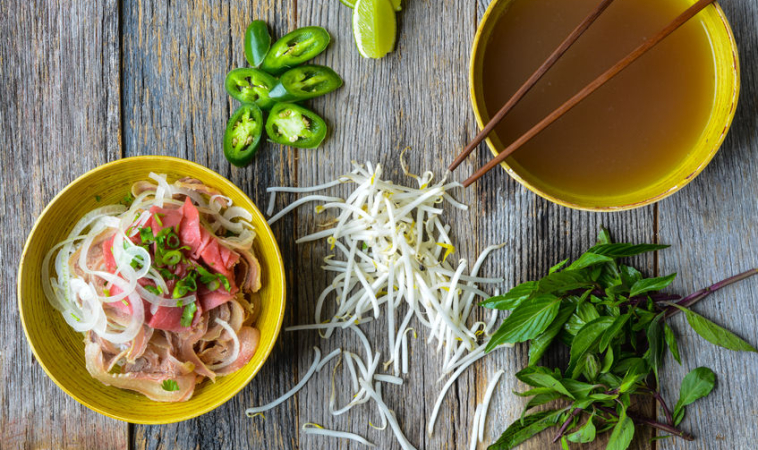Gluten-Free, Grain-Free, Dairy-Free, Vegan Variation
This recipe has everything a healthy meal should contain: vegetables, protein, and healthy fat. It’s my version of the Vietnamese favorite called pho (pronounced “fuh”). Traditionally, it’s made by layering toppings on a bed of rice noodles bathed in a fragrant broth. I wanted to make mine gluten-free and grain-free, so I substituted shredded Savoy cabbage for the noodles. Cruciferous vegetables like cabbage are good sources of fiber, vitamins, and minerals. They are also a rich source of sulfur-containing compounds like isothiocyanates and indoles associated with the prevention of many kinds of cancer including tumors of the breast, prostate, lung, colon, and rectum.1 These compounds boost antioxidant levels2 and stimulate detoxification pathways in the liver3 as well. (Learn more about cruciferous veggies and detox in my book, The Prediabetes Detox.)
I topped my pho with sautéed beech mushrooms, quartered cherry tomatoes, thinly sliced scallions, chopped cilantro, minced fresh green chili pepper, and sliced grass-fed steak. You can use any toppings you like. Other good choices would be chopped seaweed, sliced and sautéed shiitake mushroom caps, sprouts, fresh basil or mint, chopped nuts, and/or wedges of lime. Instead of beef, you could top it with seafood, chicken, or pork. For a vegetarian version, top it with a halved hard- or soft-boiled egg, cubes of sautéed tofu or tempeh, or cooked beans instead of meat. For a vegan version, use vegetable broth, mushroom broth, or bean broth instead of bone broth. As an alternative to shredded cabbage, you could substitute ribbons of spiralized zucchini.
Cruciferous vegetables are good sources of vitamins, minerals, fiber, and compounds that help prevent cancer and remove toxic compounds from the body.
This soup is just one example of how to eat meat as a condiment in a plant-based diet. It’s also an economical way to incorporate grass-fed meats into a healthy meal that the whole family can enjoy. Full of immune-supportive ingredients like ginger, garlic, cayenne, and bone broth, pho is also a nourishing meal for anyone under the weather, especially during cold and flu season. This recipe makes about 3 large (main course) bowls of soup.
Ingredients:
- 6 cups beef bone broth (find my recipe here)
- 1 large onion, chopped
- 4 dried star anise
- 1 to 2 teaspoons fresh grated ginger
- 2 cloves garlic, grated
- 1/2 teaspoon ground cinnamon
- 1/2 teaspoon ground cardamom
- 1/4 teaspoon ground clove
- 1/4 teaspoon ground fennel seeds
- 1/2 teaspoon freshly ground black or Szechuan peppercorns
- Pinch cayenne
- 1/2 teaspoon sea salt
- 6 cups shredded cabbage
- 5 ounces beech mushrooms, separated
- 3/4 to 1 pound grass-fed steak
- 2 tablespoons fish sauce
- 1 teaspoon tamari
- 1 teaspoon honey
Directions:
- Warm a soup pot over medium heat. While the bone broth is still cold, skim off any fat and add it to the pan. If there is none, use some rendered animal fat, ghee, or coconut oil. Once the fat has melted and the pan is hot, add the onion and sauté, stirring occasionally, until it’s soft and starting to brown.
- While the onion cooks, place the star anise in a small piece of cheesecloth. Tie it with organic cotton string and set it aside. You can skip this step if you’re willing to fish out the star anise later.
- Once the onion is soft and starting to brown, stir in the ginger, garlic, cinnamon, cardamom, clove, fennel, peppercorn, and salt. Continue cooking until the spices start to toast and become aromatic, another minute or two.
- Add enough of the bone broth to moisten the bottom of the pot. Use a wooden spoon to scrape up any brown bits and incorporate them into the broth. Stir in the remaining bone broth and add the star anise. Bring the mixture to a boil, then reduce the heat to low and allow the broth to simmer for 30 minutes or more.
- Add the cabbage to the broth and simmer until tender.
- While the cabbage cooks, prepare the mushrooms and steak. Sauté the mushrooms in some rendered animal fat, ghee, or coconut oil until just tender. Sear the steak over high heat. Do not move the meat until it naturally detaches from the pan and flip it only once. I cooked mine rare, which took just 4 or 5 minutes on each side of a 1-inch thick grass-fed edge of eye steak. Allow the steak to rest for 10 minutes, then slice it against the grain.
- Once the cabbage is tender, remove the star anise. Stir in the fish sauce, tamari, and honey. Taste it for seasoning and make any necessary adjustments.
- Use tongs or a slotted spoon to fill each soup bowl about 2/3 full of cabbage, forming a base solid enough to support the toppings. Ladle the broth over the cabbage, just enough to barely cover it. Arrange the garnishes on top: sliced steak, cooked mushrooms, cherry tomatoes, cilantro, scallions, and fresh chili pepper. Serve immediately.
Image Copyright: <a href=’https://www.123rf.com/profile_bbourdages’>bbourdages / 123RF Stock Photo</a>
 Sarah Cimperman, ND is the author of the new book, The Prediabetes Detox: A Whole-Body Program to Balance Your Blood Sugar, Increase Energy, and Reduce Sugar Cravings. She graduated from NCNM in 2002 and has a private practice in New York City. Her expertise has been featured on Fox News and Huffington Post and in Natural Health magazine, Whole Living magazine, and the Well Being Journal, among other publications. Dr. Cimperman also writes two blogs, A Different Kind Of Doctor and The Naturopathic Gourmet.
Sarah Cimperman, ND is the author of the new book, The Prediabetes Detox: A Whole-Body Program to Balance Your Blood Sugar, Increase Energy, and Reduce Sugar Cravings. She graduated from NCNM in 2002 and has a private practice in New York City. Her expertise has been featured on Fox News and Huffington Post and in Natural Health magazine, Whole Living magazine, and the Well Being Journal, among other publications. Dr. Cimperman also writes two blogs, A Different Kind Of Doctor and The Naturopathic Gourmet.
References:
- Abdull Razis AF and Noor NM. Cruciferous vegetables: dietary phytochemicals for cancer prevention. Asian Pacific Journal of Cancer Prevention. 2013;14(3):1565-70. http://www.ncbi.nlm.nih.gov/pubmed/23679237
- Lii CK, Liu KL, Cheng YP, Lin AH, Chen HW, and Tsai CW. Sulforaphane and alpha-lipoic acid upregulate the expression of the pi class of glutathione S-transferase through c-jun and Nrf2 activation. Journal of Nutrition. 2010;140(5):885-92. http://www.ncbi.nlm.nih.gov/pubmed/20237067
- Fowke JH, Morrow JD, Motley S, Bostick RM, and Ness RM. Brassica vegetable consumption reduces urinary F2-isoprostane levels independent of micronutrient intake. Carcinogenesis. 2006;27(10):2096-102. http://www.ncbi.nlm.nih.gov/pubmed/16704986
















